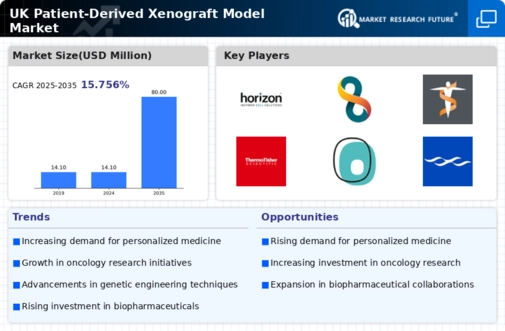Increasing Cancer Incidence
The rising incidence of cancer in the UK is a pivotal driver for the patient derived-xenograft-model market. As cancer cases continue to escalate, the demand for innovative treatment options intensifies. Patient derived xenograft models offer a unique platform for studying tumor biology and testing therapeutic responses, which is crucial for developing personalized treatment strategies. According to recent statistics, cancer cases in the UK are projected to rise by approximately 20% by 2030, necessitating advanced research models. This trend underscores the importance of patient derived-xenograft models in understanding cancer heterogeneity and improving patient outcomes. Thus, the patient-derived xenograft model market is positioned to grow significantly. Researchers and pharmaceutical companies are seeking effective solutions to combat this growing health crisis.
Regulatory Framework Enhancements
The evolving regulatory landscape in the UK is shaping the patient derived-xenograft-model market. Recent initiatives aimed at streamlining the approval processes for preclinical models are likely to accelerate research timelines and reduce costs. Regulatory bodies are increasingly recognizing the value of patient derived-xenograft models in providing relevant data for drug development, which may lead to more favorable guidelines and support for their use. This regulatory support is crucial for researchers and companies looking to bring innovative therapies to market efficiently. As the framework continues to evolve, it is anticipated that the patient derived-xenograft-model market will experience growth, driven by enhanced compliance and reduced barriers to entry.
Advancements in Genomic Technologies
Technological advancements in genomics are significantly influencing the patient derived-xenograft-model market. The integration of next-generation sequencing (NGS) and CRISPR technologies allows for more precise genetic modifications in xenograft models, enhancing their relevance in preclinical studies. These innovations enable researchers to create models that closely mimic the genetic landscape of human tumors, thereby improving the predictive power of drug responses. The UK has seen a surge in genomic research funding, with investments exceeding £1 billion in recent years, which further propels the development of sophisticated patient derived-xenograft models. As these technologies evolve, they are likely to enhance the utility of patient derived-xenograft models in drug discovery and personalized medicine, driving market growth.
Growing Investment in Oncology Research
The patient derived-xenograft-model market is benefitting from increased investment in oncology research within the UK. Pharmaceutical companies and research institutions are allocating substantial resources to develop novel cancer therapies, with oncology research funding reaching approximately £1.5 billion annually. This financial commitment fosters the creation and utilization of patient derived-xenograft models, which are essential for evaluating the efficacy and safety of new treatments. Furthermore, collaborations between academia and industry are becoming more prevalent, facilitating the sharing of resources and expertise. As the focus on cancer research intensifies, the patient derived-xenograft-model market is expected to expand, driven by the need for reliable preclinical models that can accurately predict clinical outcomes.
Rising Focus on Drug Resistance Studies
The patient-derived xenograft model market is experiencing growth due to an increasing focus on drug resistance studies. As cancer treatments become more sophisticated, understanding the mechanisms of resistance is critical for improving therapeutic efficacy. Patient derived-xenograft models provide a valuable tool for investigating how tumors adapt to therapies, enabling researchers to identify potential resistance pathways. This focus is particularly relevant in the UK, where the prevalence of treatment-resistant cancers is a growing concern. The market is likely to expand as researchers leverage these models to develop strategies that overcome resistance, ultimately leading to more effective cancer treatments. The insights gained from these studies are expected to drive innovation in the patient derived-xenograft-model market.



















Leave a Comment